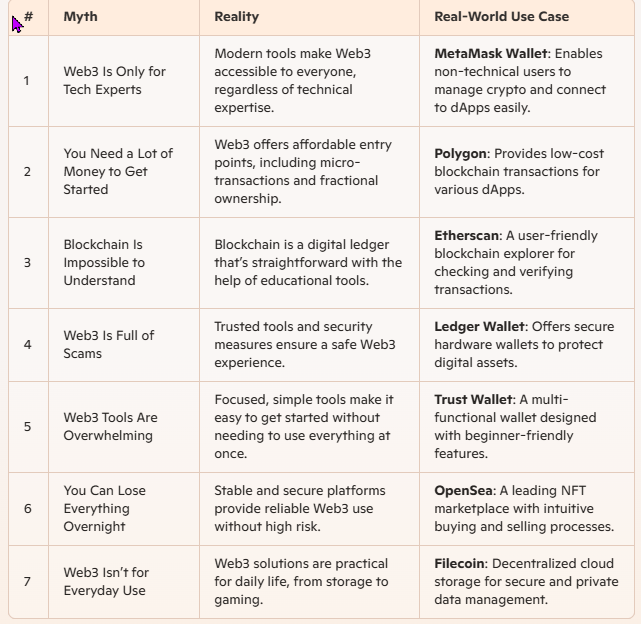Introduction: Demystifying Web3 for Everyone
Web3 often gets a reputation for being overly complex, a world only understood by tech experts and developers. But is this reputation entirely deserved? As the decentralized internet continues to grow, many people feel intimidated by terms like blockchain, smart contracts, and decentralized applications (dApps). The truth is, Web3 has become increasingly accessible to everyone, thanks to user-friendly tools and platforms designed to make entry into this new digital frontier simple and seamless.
The idea that Web3 is “too complicated” is a myth worth debunking. In this blog, we’ll tackle seven common misconceptions about Web3’s complexity and explore how practical tools are making it more beginner-friendly. By the end, you’ll see that stepping into Web3 is not only possible—it’s easier than you think.
Myth #1: You Need to Be a Tech Expert
One of the biggest misconceptions about Web3 is that it’s only for people with advanced technical knowledge, like software developers or blockchain engineers. While Web3 initially required some understanding of blockchain technology, modern tools have transformed the landscape.
Platforms like MetaMask (a Web3 wallet) and user-friendly dApps have made it possible for anyone to participate without writing a single line of code. These tools use intuitive interfaces that make actions like storing digital assets or interacting with NFTs as easy as using a traditional app.
Reality Check: If you can use a smartphone, you can use Web3.
Myth #2: You Need a Lot of Money to Get Started
Some people assume that Web3 is only for investors or those with significant financial resources. While cryptocurrencies and NFTs often make headlines with eye-popping price tags, you don’t need a fortune to start your Web3 journey.
Many blockchain platforms, like Polygon and Solana, offer low-cost or even free transactions, making it affordable for users. Additionally, platforms like Coinbase and Binance allow users to buy tiny fractions of cryptocurrencies for as little as a few dollars.
Reality Check: Web3 is for everyone, regardless of budget.
Myth #3: Blockchain Is Impossible to Understand
The word “blockchain” may sound intimidating, but the concept is actually quite straightforward. Blockchain is a type of digital ledger that records transactions securely and transparently. It’s like a shared spreadsheet that everyone can trust because no one can alter it without approval from others.
Tools like Etherscan and blockchain explorers make it easy for users to see and verify transactions. Platforms such as Alchemy provide educational resources to simplify blockchain concepts for new users.
Reality Check: Blockchain technology is simpler than it sounds, especially with today’s resources to help explain it.
Myth #4: Web3 Is Full of Scams
Like any emerging technology, Web3 has its share of risks, including scams and phishing attacks. But that doesn’t mean the entire ecosystem is untrustworthy. Web3 developers are actively creating secure platforms and resources to help users protect themselves.
For example, tools like Ledger and Trezor offer hardware wallets that provide top-notch security for your digital assets. Educational websites like CoinGecko and CryptoSlate also guide users on how to spot and avoid scams.
Reality Check: Web3 is safe when you take advantage of trusted tools and follow basic security practices.
Myth #5: Web3 Tools Are Overwhelming
With so many wallets, dApps, and platforms available, Web3 might seem overwhelming at first. But just like picking a favorite social media platform, you only need a few tools to get started.
User-friendly platforms like Trust Wallet and Brave browser simplify interactions with Web3. Many wallets provide in-app tutorials to guide users through the process of sending funds, minting NFTs, or connecting to a dApp.
Reality Check: You don’t need to master every Web3 tool—just start with a few essentials.
Myth #6: You Can Lose Everything Overnight
While volatility is a concern for cryptocurrencies, Web3 is much more than just digital currencies. By focusing on dApps, decentralized finance (DeFi), or NFTs, users can participate in the ecosystem without the fear of losing all their assets to market swings.
Tools like Aave and Compound allow users to engage in decentralized lending and borrowing securely. NFT marketplaces like OpenSea provide clear instructions for buying and selling assets, reducing the risk of mistakes.
Reality Check: With the right approach, Web3 offers plenty of stable and secure ways to participate.
Myth #7: Web3 Isn’t for Everyday Use
Many people believe Web3 is limited to niche interests like trading crypto or collecting NFTs. In reality, it’s creating practical solutions for daily life. For instance:
- Decentralized social media platforms like Lens Protocol let you connect without worrying about data privacy.
- File-sharing systems like Filecoin enable secure and decentralized cloud storage.
- Play-to-earn games like Axie Infinity let users earn rewards while having fun.
Web3 is expanding into finance, entertainment, healthcare, and more, making it increasingly relevant to everyday life.
Reality Check: Web3 is growing to meet the needs of everyday users.
User-Friendly Tools for Beginners
Here are some tools that make Web3 accessible, even for non-tech-savvy individuals:
- MetaMask: A browser extension and mobile app for managing crypto wallets and connecting to dApps.
- Trust Wallet: An easy-to-use wallet app for cryptocurrencies, NFTs, and more.
- Coinbase: A beginner-friendly platform for buying, selling, and managing digital assets.
- Brave Browser: A Web3-enabled browser focused on privacy and blockchain integration.
- OpenSea: The largest marketplace for buying and selling NFTs.
- Filecoin: A decentralized storage solution for securely saving files online.
- Aave: A platform for earning interest on crypto deposits or taking out decentralized loans.
These tools are designed with simplicity in mind, making it easier than ever to enter the Web3 space.
How Web3 Benefits Beginners
Web3 is shaping a future where users have more control over their data, assets, and online interactions. Here’s how it empowers beginners:
- Ownership: With Web3, you own your digital assets and identity—no middlemen required.
- Privacy: Blockchain technology enhances data security, reducing privacy concerns.
- Accessibility: Platforms are building beginner-friendly interfaces to onboard new users.
- Learning Resources: Educational materials, tutorials, and communities make it easy to learn.
- Opportunities: Web3 opens doors to new careers, investments, and ways to connect.
In summary we have covered 7 myths and debunked each one. To further cement these ideas, please find a chart below with real world examples:

Conclusion: Web3 Isn’t Too Complicated—It’s Evolving
The idea that Web3 is “too complicated for beginners” is rapidly becoming a thing of the past. With user-friendly tools, affordable options, and practical applications, Web3 is accessible to everyone, regardless of their technical background.
As the ecosystem grows, more resources and innovations are being developed to make Web3 even easier to use. Whether you’re curious about NFTs, DeFi, or decentralized storage, there’s a place for you in the Web3 world.
Ready to explore the exciting world of Web3? Subscribe to Web3WondersUS today for guides, tips, and insights that make your journey simple and rewarding. Don’t miss out on the future of the internet—join us now!

